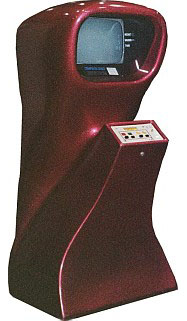
from the vault: Video Games and Contemporary Sculpture
Am (still) gradually moving content from my old Digital Media Tree website over to tommoody.us, including an index of published writing examples. I wrote the essay below in 2002 as a self-hosted web-publication. Not sure how well the funky image alignment HTML will work with modern devices but I'll keep it for now.

Product design doesn't emerge in a vacuum; it's part of a larger visual history, reflecting developments in technology, fabrication technique, and philosophy that also apply to the purer arts. Before the late '60s, when the scientific pretensions of the high modernist era began to break down, art and design seemed to move in easy parallel, influencing or being influenced by one other. Yet since that time, with the exception of the occasional visionary (or quasi-visionary oddball such as Matthew Barney), art has preferred to take itself out of the equation, offering ironic footnotes and meta-commentary rather than design per se.
For an example of a commercial object planted firmly in the modernist feedback loop, let's consider Nutting Associates' Computer Space game (1971). The first arcade-style game is clearly rooted in the space age design of the late '60s and early '70s. Its body is made of Fiberglas, one of the "new materials" that promised to revolutionize how we live, work, and shop: tough but malleable, able to be molded into pleasing, biomorphic contours, as in the Eames chair and the Corvette Stingray body. Combining the abstract curves of a Henry Moore sculpture with Apollo-era push-buttons and screen technology, Computer Space is delightfully anthropomorphic, with a bulbous head and pseudopod arm proffering its control panel like a robot butler. Typical of science fiction's use of present-day kitsch objects as futuristic props (e.g, the design-store salt shakers as medical instruments in the McCoy-era Star Trek), Computer Space appeared briefly onscreen in the 1973 Charlton Heston vehicle Soylent Green--as a game, however, rather than a piece of newfangled equipment.

Many artists of the '60s, such as George Rickey and Kenneth Snelson, made objects with the same buoyant optimism and faith in science one sees in the contours of Computer Space. Some of Canadian sculptor Walter Redinger's Fiberglas sculptures fit right in with the NASA aesthetic, while others begin to break away from the upbeat positivism of the '60s and explore its dark side. An untitled wall-piece from 1969, featuring a bizarre, quasi-fetal shape spewing out of the placid surface of a large monochrome triptych, belongs to the latter group. In Redinger's late-'60s-style rhetoric, this phallic-vaginal wraith reflects "the tension which exists between organic and geometric forms," but in retrospect it reads more as a tumorous growth on the picture plane--as if the bodily repression of the Formalist tradition were taking pathological form.

By the '80s, artists had left the design world to fend for itself as they went off to explore the outer reaches of French theory, identity politics, and institutional critique. During this period, video games became functional, box-like, and festooned with tacky graphics: the Xevious game, 1983, for example, featured epic battles of Star Wars-style space ships painted on its sides. The shapes of the consoles may have been utilitarian and ordinary, but the games were popular, thus providing a visual meme that could later be recycled within the art world's self-referential feedback-eddy.
Thus, in Rita McBride’s Machines, 2000, the shapes of "various standard video game consoles found in arcades and neglected bars around the world" (to quote the gallery press release) are presented stripped of all signage and hardware. Made of mass-produced vitreous enamel typically used for industrial signage and subways, the sculptures combine the comforting hues and textures of '50s refrigerators with shapes invoking the design-challenged, shopping-mall '80s. Unlike Redinger's work, however, which was to some extent participating in the grand experiment of its age, McBride's exists at a critical remove from the design world's cycles of innovation and cliche. It comments on the underlying social assumptions of objects without putting too much at risk. That's fine for now, but eventually we may get hungry to see a lava lamp again, as opposed to a "lava lamp."

Photos, top to bottom:
Computer Space arcade game (Nutting Associates), 1971
Walter Redinger, Untitled, 1969, Fiberglas
Xevious arcade game (Atari), 1982
Rita McBride, Machines, 2000



